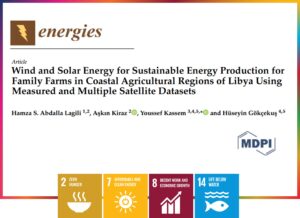
Lagili, H. S. A., Kiraz, A., Kassem, Y., & Gökçekuş, H. (2023). Wind and solar energy for sustainable energy production for family farms in coastal agricultural regions of Libya using measured and multiple satellite datasets. Energies, 16(18), 6725.
Researchers from Near East University have conducted a study aiming to assess the untapped potential of wind and solar energy in Libya's agricultural coastal regions, offering a sustainable solution to the nation's energy demand and water scarcity. This comprehensive research, the first of its kind, utilized measured data from Az-Zāwiyah, Libya, collected throughout 2022 to evaluate renewable energy prospects accurately.
The study stands out due to its reliance on daily measurement data, a significant feat amidst the challenging backdrop of civil unrest and data scarcity in Libya. By integrating multiple datasets and satellite products, including TerraClimate, ERA5, ERA5-Land, MERRA-2, and CFSR, the research team meticulously evaluated wind and solar energy potential, offering critical insights.
The findings revealed that while CFSR and ERA5-Land demonstrated optimal performance in assessing wind resources, all satellite products proved valuable for preliminary solar resource evaluations. Moreover, the study assessed the wind and solar resources in five agricultural coastal regions and examined the potential performance of wind and photovoltaic (PV) systems in meeting the energy demands of family farms.
The research highlighted the superior potential for solar energy generation over wind energy in these regions. However, it also emphasized the feasibility of implementing both small-scale wind and PV systems to meet electricity needs and potentially produce freshwater, bolstering agricultural productivity. Although the initial costs of these systems might be higher compared to conventional methods, their implementation offers myriad benefits.
Notably, the adoption of wind and PV systems contributes significantly to mitigating greenhouse gas emissions. Furthermore, these systems alleviate the strain on conventional energy sources and address critical challenges such as electricity shortages and water crises, crucial for sustainable development.
The study underscores the potential for wind and solar power to revolutionize Libya's energy landscape, offering a pathway toward sustainable development. Despite initial cost considerations, the long-term advantages, including enhanced energy security, reduced reliance on fossil fuels, and minimized environmental impacts, make these systems a compelling choice for sustainable energy generation in the country.
For further details, access the original paper from the publisher's link:
https://www.mdpi.com/1996-1073/16/18/6725